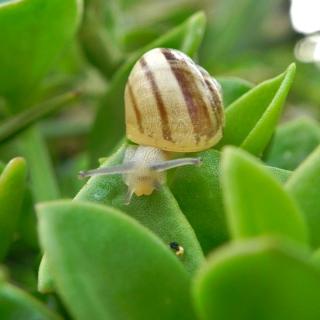

Every Spring season, it’s the same old story. You’re strolling through the garden, soaking in that frenzied feeling of nature waking up. Ka-POW, disaster strikes! Everywhere, slugs and snails chowing down on young sprouts, wispy stems standing as tiny totems to spirits of the past… Gone are your favorite flowers and vegetables! To make sure your sprightly Spring mood doesn’t swing up and down this much, follow these tips on how to control them naturally.
There are two main types of slugs in our gardens. Common garden slugs (Arion hortensis) and large black or red slugs (Arion ater). Regarding snails, you’ll probably notice the garden snail (Helix aspersa) and, though less common, the garden banded snail (Cepaea hortensis) or the grove snail (Cepaea nemoralis).
Let’s look at the patterns in the life slugs and snails.
Symptoms of slug and snail attacks are generally stems cut about an inch high (2-3 cm), with leaves missing entirely. If you notice seedlings falling over or turning yellow, it isn’t these guys: it’s “damping off” due to fungus.

These will keep Gastropoda numbers down. Among the most voracious helpers, you’ll find hedgehogs, toads, and also nematodes which are microscopic worms that parasite and attack slugs. They’re sold in garden stores and look like powder. All that’s needed is to mix them into water and spray it all over the ground.
Certain plants naturally repel slugs: thyme, chives, fennel, comfrey, garlic, centaury, etc.
Others such as chamomile tend to attract slugs to them. You can use them as decoys to draw them away from your prized crops.
Further protection is available through the use of natural barriers that discourage slugs and snails from devouring young sprouts. For instance, chimney ashes (if you have a fireplace), used coffee grounds, coarse sand or grit, and even crushed egg shells. The main drawback of these barrier techniques is that they’re washed out by rain. Therefore, they need to be replaced every time it rains.
Interestingly, snails and slugs absolutely hate slithering across copper, believe it or not! To that end, twist electric wire (after removing the plastic sheath) into a barrier you can wrap around stems or plants to create a natural anti-slug fence.
Another possibility to deal with slugs and snails is to trap them. Two options here:
The goal of this article isn’t to learn how to eradicate and kill off all slugs and snails from your garden. They’re on Earth for a reason, and, in their own way, are very helpful in a garden. They work to convert plant waste into fresh nutrients that your plants can use to grow. Your garden, in the long run, will be better off with snails and slugs than without!